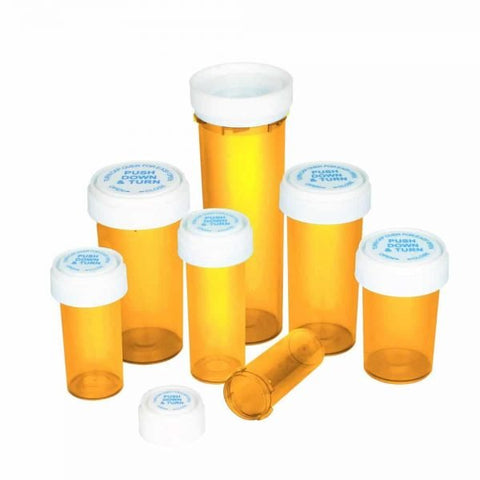If your curiosity for pharmacy vials has led you here, then you’ve come to the right place. In this post, we’ll talk about what pharmacy vials are, why they’re used, their benefits and how you can use them.
Let’s get started!
What are Pharmacy Vials?
On hearing the word “vial,” many people think of them as bottles. But as similar as they might look, there’s a fundamental difference between the both. While bottles are also made of glass or plastic, bottles are primarily used for storing normal daily liquids such as drinks, cleaning fluids, and sometimes medicines as well.
Pharmacy vials, on the other hand, is a standard term used in medicine. Pharmacy vials, also known as prescription vials, are small containers used to store medicines in liquid form, powders or tablets. These vials are made out of plastic (mostly polypropylene) and sometimes of glass as well. The bottom of vials is kept flat.
Types of Pharmacy Vials
According to their sizes and features, pharmacy vials can be divided into many types. Let’s see some of them in a bit details.
Push & Turn Vials: Push &turn Vials are one of the most widely used vials. They’re quite easy to open and yet offer CPSC Child-Resistance. To open these vials, you simply need to push and turn cap that lets you leverage the weight of their body to release the safety mechanism.

Thumb Tab Reversible Cap Vials: Frequently used as an alternative of Push & Turn vials, thumb tab reversible cap vials are quite easy to operate. All you need to do is simply push down on the tab, and twist off the cap. The cap then can be reversed and used as an easy-off method. These vials offer great child resistance as well.

Prefer Vials: Prefer vials have a distinctive wide mouth that makes it easy to fill. Moreover, they’re CPSC certified and offer child-resistant push and turn closure.

Reversible Cap Vials: These vials provide the versatility of two cap styles. You simply need to flip the cap over to switch between a secure push down and turn style mechanism and a simple screw top for easy access. Thanks to this flexibility, reversible cap vials are quite handy.

Snap Cap Vials: These vials come with EZ Open Snap-On cap that are quite easy to open. They come in various colours and sizes, making it easy to find the right fit for you.

Other Vial Types: Some of the other vial types include hinged Lid Containers, script pro Compatible Vials and Opaque Vials.

Why should You Use Pharmacy Vials?
Storing medicines requires many features such as safety, identification features, size, etc. And that’s why storing medicines and storing daily liquids are two totally different things. There are many online pharmacies as well who sell pharmacy vials, dispensary mylar bags and many other types of products. Let’s see some of the most important reasons why pharmacy vials are being used today:
Flexibility of Size: Medicines come in many different sizes and in many different forms. That’s why you need their containers to provide such flexibility, and that’s exactly what pharmacy vials provide. Pharmacy vials are available in different sizes and shapes (such as blunt tubes) and they help you store medicines in liquid, tablet and powder forms.
Childproof: Children are highly curious, and that’s a great thing – except a few times. One of those exceptions is medicines. Pharmacy vials come with child-resistant caps that prevent children from getting access to the medicine and protect their safety.
Sturdiness: Polypropylene, which is highly used in making pharmacy vials, is a durable material that doesn’t deteriorate even in cool and dry conditions. Not only that, they comply with USP standards for transmission of light and prevent the medicine from getting contaminated. Therefore, the medicine stays in good condition for a long time.
Identification and Colour Coding: Pharmacy vials are extensively used in laboratories and in research. Pharmacy vials allow great color-coding system that enables researchers to identify them by their colours. This, as a result, helps them reduce human errors. Not only that, but it also helps the pharmacy supply stores identify even prescriptions vials in wholesale.
Allow Labelling: The external surface of the pharmacy vials is plain in its nature and therefore allows to familiar labelling that makes it easy to identify the drugs. Such identification helps researchers, brands and consumers as well.







